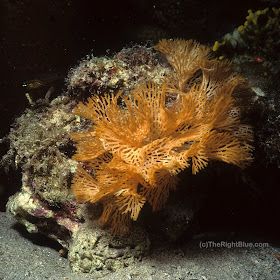BNSullivan.jpg) Here is something very beautiful that lives in the ocean that snorkelers almost never get to see. They don't get to see it because it usually lives at depths greater than 10 meters (about 30 feet or so). This is a Lace Bryozoan (Reteporelina denticulata).
Here is something very beautiful that lives in the ocean that snorkelers almost never get to see. They don't get to see it because it usually lives at depths greater than 10 meters (about 30 feet or so). This is a Lace Bryozoan (Reteporelina denticulata).Bryozoans are odd things. The colonies they build can look a bit like corals, but they are not corals at all. Bryozoans are colonial animals, and many of them -- like the ones on this page -- build calcareous structures. To that extent they also seem like a type of coral, but they are not. Biologically, they are quite distinct from corals, and in fact, the Bryozoans have a phylum all to themselves, with more than 5,000 known species.
The individuals, called zooids, usually are less than a half millimeter in length. In other words, they are microscopic. Many types of Bryozoans form encrusting colonies on rocks, corals, and other surfaces; other Bryozoan colonies look almost plant-like. We think the prettiest ones are those known as Lace Bryozoans.
The Lace Bryozoans pictured on this page can be found in many areas of the Indo-Pacific region, from the Red Sea to parts of the Pacific Ocean. They are quite common in Hawaii, especially on deep rocky terrain, and on rubble slopes at the deeper edges of the coral reefs. It's not unusual to see a colony attached to a rock or a large lump of dead coral out in the middle of a sand flat, just like the colony in the first photo on this page, even at depths of more than 30 meters (100 feet).
BNSullivan.jpg) Bryozoans are sessile animals: the base of their colonies always is very firmly anchored to the rock or coral upon which it is growing. Lace Bryozoan colonies are very brittle and therefore quite fragile. If you come across one while diving, do stop to look closely and admire it, but don't touch. If you try to handle it you will surely damage it.
Bryozoans are sessile animals: the base of their colonies always is very firmly anchored to the rock or coral upon which it is growing. Lace Bryozoan colonies are very brittle and therefore quite fragile. If you come across one while diving, do stop to look closely and admire it, but don't touch. If you try to handle it you will surely damage it.The photo at left shows a relatively new colony, just about one inch across (about 2.5 cm). We spotted it out on a deep sandslope as we swam over it. It looked like it was growing right out of the sand, but it was not. It was attached to a rock that was buried.
Mature colonies of this particular species of Lace Bryozoan look like ruffled lace nosegays. A colony can measure up to about four inches (10 cm) across.
As you might have guessed, all of the photos on this page are macro photos. Each is of a different colony of Reteporelina denticulata. I photographed them off the coast of Puako, Hawaii, at depths in the 30-40 meter range (about 100 to 120 feet). I've reduced the size of the photos so that they would fit better on the page, but if you click on any of the images they will enlarge so that you can see more details of their lacy structure.
BNSullivan.jpg)
With over 5,000 species, the Bryozoans deserve their own phylum!
ReplyDeleteUp to four inches across? I'm glad you mentioned that: I imagined the first colony was over a foot wide.
Wasn't sponge bob a bryozoan? Stunning photos and would love to see one in real life!
ReplyDeleteYour shots are always amazing. I find it really interesting that these things that look more like plants than an animal are actually animals.
ReplyDeleteI won't pretend I understand all the intricacies of the biology, but that last photo is gallery quality!
ReplyDeleteSo each of the feathery leaves is made up of thousands and thousands of animals, the way coarl is? Wow! I would have thought that the colonies were plants, without your information!
ReplyDeleteThey are beautiful animals!!
Thanks for sharing! And I agree with Mojo about that last photo!
@ lavenderbay - That's exactly why I try to remember to tell readers how big (or small) a photo subject is in real life. With close-ups/macros it's often hard to tell from the photo.
ReplyDelete@ mon@rch - I know nothing of Sponge Bob's lineage, but I suspect -- given the name -- that he is a sponge, not a bryozoan?
@ 2Sweet - There are other Bryozoan colonies that really look like plants -- they even waft back and forth in the current like seaweed.
@ Mojo - Thank you very much. The Right Blue IS my gallery. ;-}
@ Judy - Thank you. Yes, each photo shows a colony of thousands of eensy weensy animals.
Bobbie
Bryozoans... now there is a word I haven't heard since my college zoology class a few decades ago. Great pictures they really do look like a type of lace.
ReplyDeleteYes of course my WW picture is of David goofing around with his camera. The Nikon D40 is such a great camera that several of our friends have bought one after getting a chance to use ours. Great minds think alike. Happy WW!
Hi Shannon - Aha! I was right! I knew I recognized that camera in the picture on your post -- I have a D40x. It's a great camera, for sure.
ReplyDeleteBobbie